Likelihood ratios of mixtures of normals
Kyle Cranmer, Juan Pavez, Gilles Louppe, March 2016.
%matplotlib inline from matplotlib import pyplot as plt import numpy as np import theano import theano.tensor as T
Toy problem
Let us consider two 1D distributions $p_0$ and $p_1$ for which we want to approximate the ratio $r(x) = \frac{p_0(x)}{p_1(x)}$ of their densities.
- $p_1$ is defined as a mixture of two gaussians;
- $p_0$ is defined as a mixture of the same two gaussians + a bump.
from carl.distributions import Normal from carl.distributions import Mixture components = [ Normal(mu=-2.0, sigma=0.75), # c0 Normal(mu=0.0, sigma=2.0), # c1 Normal(mu=1.0, sigma=0.5) # c2 (bump) ] bump_coefficient = 0.05 g = theano.shared(bump_coefficient) p0 = Mixture(components=components, weights=[0.5 - g / 2., 0.5 - g / 2., g]) p1 = Mixture(components=components[:2], weights=[0.5, 0.5])
Note: for $p_0$, weights are all tied together through the Theano shared variable g. This means that changes to the value stored in g also automatically change the weight values and the resulting mixture.
Next we generate an artificial observed dataset X_true.
X_true = p0.rvs(5000, random_state=777)
reals = np.linspace(-5, 5, num=1000) plt.plot(reals, p0.pdf(reals.reshape(-1, 1)), label=r"$p(x|\gamma=0.05)$", color="b") plt.plot(reals, p1.pdf(reals.reshape(-1, 1)), label=r"$p(x|\gamma=0)$", color="r") plt.hist(X_true[:, 0], bins=100, normed=True, label="data", alpha=0.2, color="b") plt.xlim(-5, 5) plt.legend(loc="best", prop={'size': 8}) #plt.savefig("fig1a.pdf") plt.show()
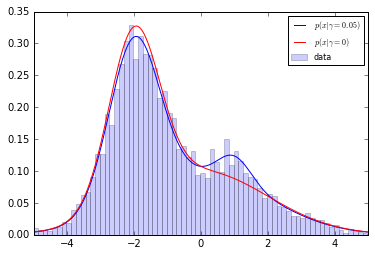
Density ratio estimation
The density ratio $r(x)$ can be approximated using calibrated classifiers, either directly by learning to classify $x \sim p_0$ from $x \sim p_1$, calibrating the resulting classifier, or by decomposing the ratio of the two mixtures as pairs of simpler density ratios and calibrating each corresponding pair-wise classifier.
from sklearn.model_selection import StratifiedShuffleSplit from sklearn.neural_network import MLPRegressor from carl.ratios import ClassifierRatio from carl.ratios import DecomposedRatio from carl.learning import CalibratedClassifierCV n_samples = 200000 clf = MLPRegressor(tol=1e-05, activation="logistic", hidden_layer_sizes=(10, 10), learning_rate_init=1e-07, learning_rate="constant", algorithm="l-bfgs", random_state=1, max_iter=75) # No calibration cc_none = ClassifierRatio(base_estimator=clf, random_state=1) cc_none.fit(numerator=p0, denominator=p1, n_samples=n_samples) # Calibration + Direct approximation cv = StratifiedShuffleSplit(n_iter=1, test_size=0.5, random_state=1) cc_direct = ClassifierRatio( base_estimator=CalibratedClassifierCV(clf, bins=15, cv=cv), random_state=0) cc_direct.fit(numerator=p0, denominator=p1, n_samples=n_samples) # Calibration + Decomposition of the mixture cc_decomposed = DecomposedRatio(ClassifierRatio( base_estimator=CalibratedClassifierCV(clf, bins=20, cv=cv), random_state=0)) cc_decomposed.fit(numerator=p0, denominator=p1, n_samples=n_samples)
Note: CalibratedClassifierRatio takes three arguments for controlling its execution:
base_estimatorspecifying the classifier to be used (note commentedExtraTreesRegressor),calibrationspecifying the calibration algorithm ("kde","histogram", or a user-defined distribution-like object),cvspecifying how to allocate data for training and calibration.
Next we plot $\log r(x)$ vs. $x$ for the different cases.
plt.plot(reals, -p0.nll(reals.reshape(-1, 1)) +p1.nll(reals.reshape(-1, 1)), label="Exact ratio") plt.plot(reals, cc_none.predict(reals.reshape(-1, 1), log=True), label="No calibration") plt.plot(reals, cc_direct.predict(reals.reshape(-1, 1), log=True), label="Calibration") plt.plot(reals, cc_decomposed.predict(reals.reshape(-1, 1), log=True), label="Calibration + Decomposition") plt.xlim(-5, 5) plt.ylim(-0.5, 0.5) plt.legend(loc="best", prop={'size': 8}) #plt.savefig("fig1c.pdf") plt.show()
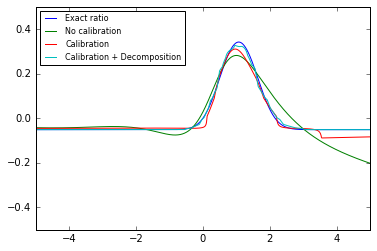
Below is an alternative plot (that works in higher dimensions when the true likleihood is known) to check if the uncalibrated classifier is monotonically related to the true likelihood ratio.
plt.scatter(-p0.nll(reals.reshape(-1, 1)) + p1.nll(reals.reshape(-1, 1)), cc_none.classifier_.predict_proba(reals.reshape(-1, 1))[:, 0], alpha=0.5) plt.xlabel("r(x)") plt.ylabel("s(x)") plt.show()
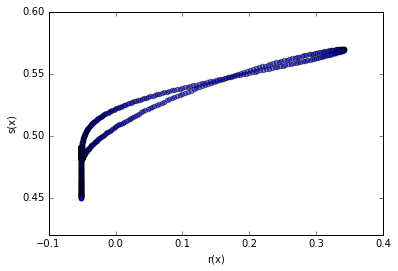
Now we inspect the distribution of the exact $\log {r}(x)$ and approximate $\log \hat{r}(x)$.
g.set_value(bump_coefficient) X0 = p0.rvs(200000) plt.hist(-p0.nll(X0) + p1.nll(X0), bins=100, histtype="step", label="Exact", normed=1) plt.hist(cc_decomposed.predict(X0, log=True), bins=100, histtype="step", label="Approx.", normed=1) plt.yscale("log") plt.legend() #plt.savefig("fig1e.pdf") plt.show()
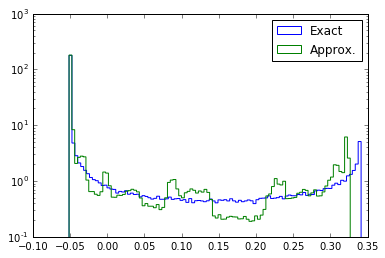
Using density ratios for maximum likelihood fit
Next let us construct the log-likelihood curve for the artificial dataset.
def nll_true(theta, X): g.set_value(theta[0]) return (p0.nll(X) - p1.nll(X)).sum() def nll_approx(theta, X): g.set_value(theta[0]) return -np.sum(cc_decomposed.predict(X, log=True))
g_scan = np.linspace(0.0, 2 * bump_coefficient, 50) nll_true_scan = np.array([nll_true([t], X_true) for t in g_scan]) nll_approx_scan = np.array([nll_approx([t], X_true) for t in g_scan]) plt.plot(g_scan, nll_true_scan-nll_true_scan.min(), label="Exact") plt.plot(g_scan, nll_approx_scan-nll_approx_scan.min(), label="Approx.") plt.legend() #plt.savefig("fig1f.pdf") plt.show()

A nice approximation of the exact likelihood.
Ensemble tests
Now let us perform an ensemble test with 1000 repeated experiments. We will use this to check bias of the maximum likelihood estimator and the asymptotic distribution of $-2\log \Lambda(\gamma)$ (ie. Wilks's theorem).
from sklearn.utils import check_random_state from scipy.optimize import minimize n_trials = 1000 true_mles = [] true_nll = [] approx_mles = [] approx_nll = [] for i in range(n_trials): # Generate new data g.set_value(bump_coefficient) X_true = p0.rvs(5000, random_state=i) # True MLE results = minimize(nll_true, x0=[0.1], args=(X_true,), constraints=[{'type':'ineq', 'fun': lambda x: x[0]}, {'type':'ineq', 'fun': lambda x: 1. - x[0]},]) true_mles.append(results.x[0]) true_nll.append(2. * (nll_true([bump_coefficient], X_true) - results.fun)) # Inference with ratios results = minimize(nll_approx, x0=[0.1], args=(X_true,), constraints=[{'type':'ineq', 'fun': lambda x: x[0]}, {'type':'ineq', 'fun': lambda x: 1. - x[0]},]) approx_mles.append(results.x[0]) approx_nll.append(2. * (nll_approx([bump_coefficient], X_true) - results.fun))
true_mles = np.array(true_mles) true_mles = true_mles[np.isfinite(true_mles)] approx_mles = np.array(approx_mles) approx_mles = approx_mles[np.isfinite(approx_mles)] np.mean(true_mles), np.mean(approx_mles)
(0.050114731275088642, 0.050060529983498012)
h = plt.hist(true_mles, bins=30, normed=1, alpha=0.2, color="b", label="Exact MLEs") h = plt.hist(approx_mles, bins=30, normed=1, alpha=0.2, color="g", label="Approx. MLEs") plt.vlines(bump_coefficient, 0, h[0].max()+5, linestyles="dashed", label=r"$\gamma = 0.5$") plt.legend() #plt.savefig("fig2a.pdf") plt.show()
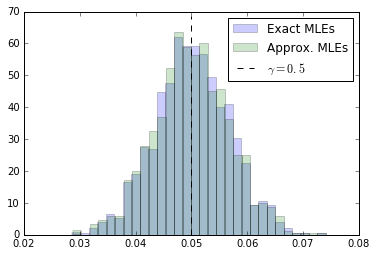
from scipy.stats import chi2 bins = np.linspace(0, 9, 50) test = np.linspace(0, 9, 100) true_counts, _, _ = plt.hist(2 * true_nll, bins=bins, normed=1, alpha=0.2, label="Exact") approx_counts, _, _ = plt.hist(2 * approx_nll, bins=bins, normed=1, alpha=0.2, label="Approx.") plt.plot(test, chi2.pdf(test, df=1), lw=2) plt.legend() #plt.savefig("fig2b.pdf") plt.show()

 Top
Top